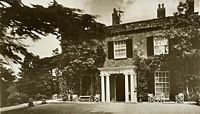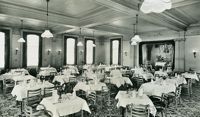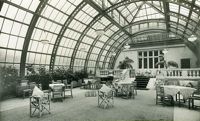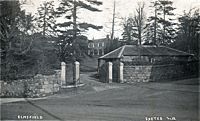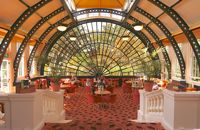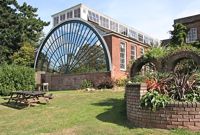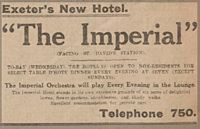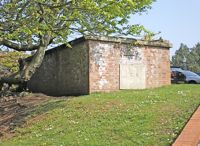
The Imperial Hotel, New North Road
Page updated 11th December 2020
Elmfield House
On the 19th January 1809, the Exeter Flying Post carried the following advert:
'To be sold, 34 Elm Trees of large dimensions now growing in a field on St David's Hill. Auction at the Plume of Feathers, Saturday 28 January. For viewing apply to Messrs Hicks and Son.'
This was the plot upon which the Imperial now
stands, and from where it took its former name, Elmfield House. James
Green, the County Surveyor, who built the Exeter canal basin,
purchased the six acres of land above what would become St David's
Station, and designed a house that matched his position. Elmfield
House was completed in 1810 and for the next dozen years, or so, it
was the home of Green, his wife Ruth and two young sons. The original
entrance, complete with lodge for the 6 acre estate, was located on
the corner of St David's Hill and Howell Road. The gate and lodge
still exist at the exit from the car park.
James Green sold Elmfield House sometime around 1822 to one George
Sparkes. He was a member of a prominent Quaker family that owned the
General Bank in Exeter. His brother, Joseph Sparkes developed
Pennsylvania Park. George's time at Elmfield was short for he died in
1824 from 'gout of the stomach' at the age of 54. The house was
advertised for sale on the 20th April 1826 in the Flying Post. It is
not certain who owned the house between 1826 and 1835.
The next prominent owner of Elmfield lasted somewhat longer than
George Sparkes. John Hall Gage, a serving army officer, moved into the
house in 1835. He was a prisoner of war of the French after being
shipwrecked near Calais, served at the Cape of Good Hope and Mauritius
before retiring with the rank of General in 1841. He died in 1854 at
the age of 78. His wife Harriet is listed in residence in the 1861
census , along with her cousin Mary M Christie and the usual servants,
until her death in 1864 - John and Harriet Hall are buried in St
David's Churchyard.
William Danby and his wife moved into the house in 1865 - originally
from Yorkshire, he was listed in a census return for Elmfield as a
Land and Fund Holder. When he died in 1897, his estate was worth
£105,217 13s 8d, an amount that is the equivalent of several million
today. His wife died in the same year. A stained-glass window and
brass plaque were installed in St David's Church in their memory, by
their daughter.
Improvements are made
The next owner of Elmfield was Dr William Buller
Heberden, who purchased the house in 1897, on his retirement. The
eldest son of the Rev. William Heberden, vicar of Broadhembury, he was
sent to school in Exmouth, along with his cousin Redvers Buller.
Heberden gained a BA in 1860 from Christ Church, Oxford and joined the
Inland Revenue. By his retirement, he had been awarded the Commander
of the Bath for his 37 years service. He became involved in the
running of the Royal Devon and Exeter Hospital and the West of England
Institute for the Blind, became a Justice of the Peace for Wonford and
a churchwarden at St David's.
William Heberden was a keen gardener and made many improvements to the
grounds of Elmfield. The gardens are south facing and contain many
cedars and firs along with a pond and fountain. One of the mature
cedars was blown over in a gale a few years ago, and a car belonging
to an unfortunate customer was written off. He was also noted for his
research into the study and treatment of arthritis. It was Heberden
who installed the barrel-vaulted conservatory, known as the Orangery,
which had previously been part of Streatham
House. The grounds were a popular venue of St Davids community,
during his tenure, for hosting annual fetes. At his death in 1922, he
left £74,087.
The Imperial Hotel
The house was then sold and converted into a 29
bedroom hotel, when a new entrance was made from New North Road.
Previously, the house was approached from the entrance on the corner
of Howell Road and St Davids Hill. Renamed, the Imperial Hotel it
opened, in May 1923. Mrs M Pollard was listed as the first proprietor
in 1923 and again in 1934.
It was conveniently situated for St David's station and was on a tram
route into the city. In its heyday, in the summer months, guests were
entertained at dinner by the 'Imperial Orchestra'. The gardens could
provide the hotel with fresh vegetables, and fruit from its Peach
House and vineries were available through the year.
In 1924, there was a report of a fire in the dining-room that filled a bedroom above with smoke. Quick action by Superintendant Pett of the Exeter Fire Brigade found a large beam built into a chimney that had probably been smouldering for a week.
Through the 1920s, the Hotel gained in popularity, and many organisations used its facilities. The hotel was the headquarters of the West of England Motor Club, and was the start point for many motor rallies and hill climbs. At every Christmas and New Year a full programme of dinners with dancing were held. One year, a Cinderella Dance was held, at which, a shoe was hidden in the ballroom at midnight, and the guests then had to find it. The lucky winner won a prize.
The play Fame, which was performed at the Theatre Royal in September 1929, after a run at St James' Theatre, London, was written by sisters Audrey and Waveney Carten, while staying at the Imperial Hotel. The play is about an unknown violinist who marries the daughter of an aristocrat, and has an attack of paralysis at the height of his fame.
After the Second War, the hotel hosted sales of Devon wool for the Ministry of Agriculture. In May 1950, 1,530,000 lb(683 tons) of wool was sold. This was the last involvement with wool sales in Exeter, a trade that made the city rich in the Seventeenth and Eighteenth Centuries.
A Murder then Wetherspoons moves in
The hotel was the subject of plans by the Royal
College of Nursing to take it over and open a training and conference
centre for nurses. The project extended to adding an 80,000 sq ft
extension. The idea was never implemented.
Then, in the late 1970's a murder enquiry took place when the body of
a woman was found in undergrowth, in the grounds. Although unconnected
with the discovery, there had been a Divorced, Separated and Singles
Club running the night previous to the discovery, and the organiser
and some of the guests were briefly questioned.
It was in the late 1980's that the Williams-Hawkes family who had run
the hotel for forty years sold to a Plymouth accountant. It almost
became an annex of Exeter College before Wetherspoons purchased it in
August 1994, spending £1.5 million on the refurbishment, to open to
the public on 14th March 1996. The upper floors were converted into 9
self-contained apartments. The original lodge and coach house at the
lower entrance are also dwellings. The main building is Grade II
listed.
Source - Research provided to me by Steve Coombes. The Exeter City Guide for 1930, Exeter and Plymouth Gazette and the Western Times.
? Top of Page ?
